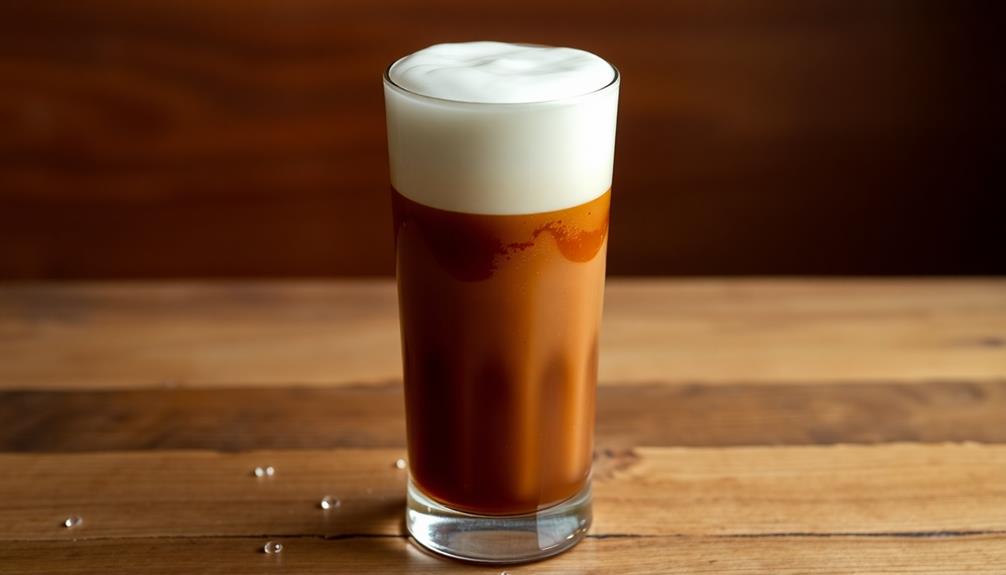Krupnik, the beloved Polish barley soup, is a comforting delight that's been warming hearts for centuries. This hearty dish blends tender barley, aromatic veggies, and a rich, flavorful broth – it's the perfect nourishment for cold winter days. Originating from humble peasant roots, Krupnik has evolved with regional variations, but its essence remains the same: a soul-soothing bowl that connects you to Eastern European culinary heritage. Whether served as a main course or a starter, Krupnik's versatility shines through, with endless possibilities for garnishes and accompaniments. Keep reading to uncover the full story behind this beloved soup and learn how to craft it yourself. And for those looking to explore more Polish cuisine, it’s worth delving into the sour rye soup recipe, another traditional dish that has stood the test of time. This tangy soup, known as żurek, combines fermented rye flour with hearty ingredients like sausage and hard-boiled eggs for a unique and savory flavor profile. Together, these two iconic Polish soups offer a taste of history and tradition that continues to comfort and delight food enthusiasts around the world.
Key Takeaways
- Krupnik is a traditional Polish and Lithuanian barley soup that originated in the 16th century as a hearty dish for nourishment during harsh winters.
- The core ingredients of Krupnik include pearl barley, broth, and root vegetables like onions and carrots, which provide essential nutrients and flavor.
- Krupnik is a beloved staple in Eastern European cuisines, often served during family gatherings or festive occasions, and represents comfort food and cultural heritage.
- Barley in Krupnik is rich in fiber, promoting digestive health, while the vegetables contribute essential vitamins and minerals for overall well-being.
- The preparation of Krupnik involves soaking the barley overnight, simmering the ingredients to develop flavors, and garnishing with fresh herbs like dill for a complete and satisfying dish.
History
Krupnik's origins can be traced back to the 16th century, when Polish and Lithuanian peasants first crafted this hearty barley soup as a way to nourish themselves during the long, harsh winters.
Over the centuries, the recipe has evolved, with each region and household putting their own spin on the classic dish. Some added carrots or onions for extra flavor, while others incorporated potatoes or beans for heartiness.
Despite these variations, the core ingredients – barley, broth, and a selection of root vegetables – have remained the same.
Krupnik became a beloved staple, passed down through generations and celebrated as a comforting taste of home.
Today, this traditional soup continues to be enjoyed across Eastern Europe, a cherished connection to the past and a testament to the enduring power of simple, wholesome ingredients.
Whether served piping hot on a chilly day or savored as a nostalgic reminder of childhood, Krupnik's history is as rich and fulfilling as the soup itself.
Recipe
Krupnik, a traditional Polish barley soup, is a comforting and nutritious dish that has been enjoyed for generations. This versatile soup can be a hearty meal on its own or a flavorful accompaniment to a variety of dishes.
The key to a delicious Krupnik lies in the careful selection and preparation of the ingredients. The soup's rich, savory broth is the foundation, while the tender barley and an array of aromatic vegetables create a harmonious blend of flavors and textures.
Ingredients:
- 1 cup pearl barley
- 8 cups beef or chicken broth
- 1 onion, diced
- 2 carrots, peeled and sliced
- 2 celery stalks, sliced
- 2 potatoes, peeled and cubed
- 2 bay leaves
- 1 teaspoon dried marjoram
- Salt and pepper to taste
Instructions:
In a large pot, bring the broth to a boil over high heat. Add the barley, reduce the heat to medium-low, and simmer for 30-40 minutes, or until the barley is tender.
Add the onion, carrots, celery, and potatoes, and continue simmering for an additional 20-25 minutes, or until the vegetables are tender. Stir in the bay leaves and dried marjoram, and season with salt and pepper to taste.
Tips:
For a heartier soup, consider adding diced ham, sausage, or shredded chicken to the mix.
Garnish the Krupnik with a sprinkle of fresh parsley or dill for an extra touch of freshness. The longer the soup simmers, the more the flavors will meld, so feel free to let it simmer for up to an hour to achieve your desired level of richness and depth.
Cooking Steps
First, you'll want to soak the barley overnight, then drain and rinse it thoroughly.
Next, add the carrots and onions and let the mixture simmer until the barley is tender.
Step 1. Soak Barley Overnight

Soaking the barley overnight is a crucial first step in preparing the traditional Polish soup, Krupnik. This simple yet essential technique allows the barley to soften and plump up, creating a heartier, more satisfying texture in the final dish.
Start by placing the barley in a large bowl and covering it with at least 2 inches of cool water. Cover the bowl and let it sit on the counter for 8-12 hours, or overnight. You'll know the barley is ready when it has absorbed most of the water and expanded in size.
Drain the barley in a colander, then give it a quick rinse under cool running water. This step removes any excess starch, ensuring the grains don't become too sticky or gloppy.
With the barley prepped and ready, you're one step closer to enjoying the rich, comforting flavors of traditional Krupnik soup.
Step 2. Drain and Rinse Soaked Barley

After letting the barley soak overnight, you'll want to drain and rinse it before proceeding with the recipe.
Grab a colander and place it in the sink. Carefully pour the soaked barley into the colander, allowing the water to drain out. Once drained, give the barley a gentle rinse under cool running water. This helps remove any residual starch or impurities from the grains.
With the barley now clean and ready to go, you can move on to the next step.
Give the barley a few shakes to remove excess water, then transfer it to a large pot. It's time to start building the flavorful broth that will make this krupnik (barley soup) so delicious.
Add your aromatic vegetables, herbs, and seasonings, and let the soup simmer away, filling your kitchen with mouthwatering aromas. Before you know it, you'll have a hearty, nourishing soup ready to enjoy.
Step 3. Add Carrots and Onions

To begin, add the diced carrots and onions to the pot with the soaked barley. The colorful carrots and aromatic onions will add delightful flavors and textures to your hearty soup.
As the vegetables sizzle in the pot, their natural sugars will caramelize, creating a rich, complex base for the broth.
Stir the carrots and onions occasionally, allowing them to soften and blend seamlessly with the barley. The carrots will lend a subtle sweetness, while the onions will provide a savory depth.
Together, they'll enhance the overall heartiness of the soup, making each spoonful even more satisfying.
Remember to adjust the heat as needed, ensuring the vegetables cook through without burning. The perfect balance of tender-crisp carrots and melt-in-your-mouth onions will elevate the krupnik, transforming it into a truly comforting and nourishing meal.
Step 4. Simmer Until Barley Is Tender

Once the carrots and onions have had a chance to cook, it's time to let the barley simmer until it's tender.
You'll want to turn the heat down to low and let the soup gently bubble away, stirring occasionally. The barley will slowly break down, releasing its starch and creating a wonderfully creamy texture in the broth.
As it simmers, you'll notice the grains softening and expanding, transforming the soup into a heartwarming and satisfying meal. Be patient – it may take 30 to 45 minutes for the barley to become fully tender.
Breathe in the comforting aroma as the soup simmers, and get ready to enjoy a bowl of delicious, nourishing krupnik.
Step 5. Garnish With Fresh Dill

Just before serving, chop up some fresh dill. The vibrant green leaves will add a burst of flavor and aroma to your homemade krupnik.
Gently tear or snip the dill fronds with your fingers, releasing their herbal scent. Sprinkle the fragrant dill over the top of your steaming bowl of barley soup, letting the delicate fronds float on the surface.
The dill's slight licorice note perfectly complements the earthy, nutty taste of the barley. Its delicate fronds also add a beautiful visual touch, making your krupnik look as appetizing as it tastes.
Feel free to use as much or as little dill as you prefer – a little goes a long way in enhancing the overall flavor.
Garnishing with fresh dill is the final step in bringing this comforting, homemade soup together. Enjoy the bright, herbaceous notes in every spoonful.
Final Thoughts
As you've now learned, creating a hearty and flavorful Krupnik, or barley soup, is a rewarding culinary endeavor. The satisfying blend of tender barley, savory broth, and aromatic herbs makes for a comforting and nourishing meal.
While the recipe may seem simple, the attention to detail in each step is what elevates this traditional dish to new heights.
Don't be afraid to experiment with different garnishes or accompaniments to suit your personal taste. A sprinkle of fresh dill, a dollop of sour cream, or a side of crusty bread can all enhance the flavors.
The beauty of Krupnik lies in its versatility – it can be enjoyed as a hearty main course or as a soothing starter.
As you continue to hone your soup-making skills, remember that the process is just as important as the final product. Embrace the therapeutic nature of chopping, simmering, and stirring, and let the aromas fill your kitchen.
Krupnik isn't just a dish, but a culinary experience to be savored and shared.
Frequently Asked Questions
What Is the Origin of the Name "Krupnik"?
You know, the name "krupnik" has an interesting origin!
It actually comes from the Polish word "krup," which refers to a type of coarsely ground grain or groats.
So, the name "krupnik" essentially means "soup made with krup."
Isn't that neat? It's a perfect way to describe this hearty, traditional barley soup.
I bet just thinking about the savory flavors and comforting warmth of krupnik makes your mouth water!
Can Krupnik Be Made With Other Grains Besides Barley?
You bet, krupnik can absolutely be made with other grains besides just barley!
In fact, the name "krupnik" actually refers to the thick, hearty soup itself, not the specific ingredients.
So feel free to experiment and try making krupnik with different whole grains like buckwheat, millet, or even oats.
The end result will have a slightly different flavor, but it'll still be that warm, comforting soup you know and love.
Get creative in the kitchen and see what delicious variations you can come up with!
How Long Does Krupnik Typically Take to Prepare?
Typically, preparing a hearty krupnik soup takes around 1-2 hours. The key is simmering the grains until they become tender and the flavors meld.
You'll start by sautéing aromatic veggies like onions and carrots, then adding your choice of grains – maybe barley, millet, or even buckwheat.
Patience is key as the soup slowly develops its rich, comforting taste. The end result is a warming, nourishing bowl that's well worth the wait!
Is Krupnik a Traditional Dish in Other Countries?
You might be surprised to learn that krupnik, the hearty barley soup, isn't just a traditional dish in Poland.
In fact, similar versions of this comforting soup can be found across Eastern Europe and the Balkans, each with its own unique twist.
From Lithuania's kruopa to Ukraine's hrechana, these warming broths often feature grains, vegetables, and sometimes meat, reflecting the rich culinary heritage of the region.
Can Krupnik Be Frozen for Later Use?
Absolutely! Krupnik, or any hearty soup, can be easily frozen for later enjoyment.
Just let it cool completely, then pour into airtight containers or freezer bags.
When you're ready to savor it again, simply thaw in the fridge overnight and reheat on the stovetop.
The flavors will stay fresh, and you'll have a delicious, homemade meal ready in no time.
Freezing is a fantastic way to extend the life of your favorite soups and stews, so you can enjoy them anytime.










